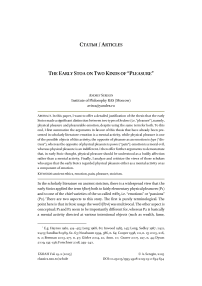The Early Stoa on Two Kinds of “Pleasure”
Автор: Andrei Seregin
Журнал: Schole. Философское антиковедение и классическая традиция @classics-nsu-schole
Рубрика: Статьи
Статья в выпуске: 2 т.19, 2025 года.
Бесплатный доступ
In this paper, I want to offer a detailed justification of the thesis that the early Stoics made a significant distinction between two types of hedone (i.e. “pleasure”), namely, physical pleasure and pleasurable emotion, despite using the same term for both. To this end, I first summarize the arguments in favour of this thesis that have already been presented in scholarly literature: emotion is a mental activity, while physical pleasure is one of the possible objects of this activity; the opposite of pleasure as an emotion is lype (“distress”), whereas the opposite of physical pleasure is ponos (“pain”); emotion is a moral evil, whereas physical pleasure is an indifferent. I then offer further arguments to demonstrate that, in early Stoic thought, physical pleasure should be understood as a bodily affection rather than a mental activity. Finally, I analyze and criticize the views of those scholars who argue that the early Stoics regarded physical pleasure either as a mental activity or as a component of emotion.
Ancient ethics, emotion, pain, pleasure, stoicism
Короткий адрес: https://sciup.org/147251462
IDR: 147251462 | DOI: 10.25205/1995-4328-2025-19-2-634-654


